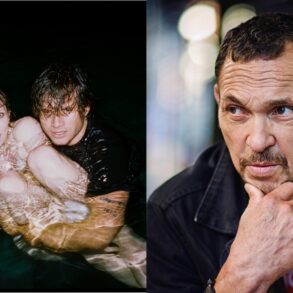Keith Haring hit it big in the early 1980s. By the time of his death at 31, in 1990, his name had become a byword around the world for creative flow. Also, for joy.
Earnest, apparently guileless, Haring was a tireless worker who wanted to democratize art. He combined drawing, graffiti and live performance with political activism and the dynamics of celebrity and commerce. Infusing his work with the special energy of 1980s New York, he connected art with music, dance and fashion, pulling it out of museums and private homes and dragging it into the street and the subway system and onto the clothes people wore.
“Radiant,” Brad Gooch’s biography of the artist, does exactly what biographies of the exceptionally famous should do: Gently, graciously, it reels in the myth, restoring the flesh-and-bone reality of this skinny, gay kid from Kutztown, Pa. Gooch, the author of previous biographies of Flannery O’Connor and Frank O’Hara, among others, acknowledges complicating facts (Haring was not always nice) and gives voice to forgotten but important ancillary figures: early champions, perceptive detractors, worried parents, forgotten collaborators, burned boyfriends, even a first girlfriend (“No question he enjoyed himself” sexually, she said, “or I would have noticed”).
Since Haring’s life was so short, months, rather than years, are the book’s governing unit of time, and the consequent level of detail — including long lists of party attendees — occasionally becomes repetitive. At times, the narrative left me in a funk of comparative exhaustion: As Haring flew around the world, constantly high, creating giant murals, painting public bathrooms, befriending celebrities, cruising for sex and partying, I struggled to rise from the couch to put the kettle on.
I love Haring’s work, which has clear affinities with the art of A.R. Penck, Jean Dubuffet, Fernand Léger and Pierre Alechinsky, among others. When he danced, according to a friend from his student days in Pittsburgh, he “had a bottom beat,” or natural rhythm, and that sense of rhythm is palpable in his drawing. The explosion of graffiti on New York’s subway, in which he participated from 1980 on, contributed to his vision of a more public-facing art. The dynamism of his figures and the clean flow of his lines feel like expressions of the same energies that fed into hip-hop, turn-tabling and break dancing.
Inspired by cartoons, Haring developed a syntax of faceless figures with spaghetti limbs, erect penises and pregnant bellies, as well as televisions, spaceships, snakes, dogs and crowns. His ubiquitous accent lines populated negative space and expressed animation. His images, executed in the spontaneous spirit of “automatic writing,” accrue meanings even as they confound attempts to parse them definitively. “At the beginning I didn’t know what they meant,” he said, “but after they existed, just by their existence and repeating them and elaborating on them, the meanings developed.”
The way Haring’s art unfurled almost in modular fashion made it flexible enough to scale up or down, and thus suitable not only for murals but for three-dimensional surfaces, from vases to BMWs. He was of course best-known for his “Radiant Baby” drawings — cartoon infants surrounded by rays of energy, described by one critic as “the first believable twentieth-century halo.” “The ‘baby’ has become my logo or signature,” Haring said, because “it is the purest and most positive experience of human existence.”
Even after his breakthroughs and ensuing fame, Haring was conspicuously not “cool.” Rather, he was sincere, exuberant, relentlessly positive. He longed simply to communicate, and his “humanism,” Gooch writes, “was unironic.” Even at its most pointedly political, his art manifested the special energy of American naiveté — the belief in human betterment, social improvement and technological progress.
“Innocence,” Gooch writes, “was the west wind that blew through much of Haring’s work.” One of his early nicknames was “Swee’Pea,” borrowed from the baby character in Popeye. The name, Gooch writes, “fit the boyish, sweet, innocent, immature qualities Keith projected.”
But innocence and a certain callowness go hand in hand, and part of a biographer’s duty is to remind us that the self you project doesn’t always match the self others see. Thus we learn that Haring could be “showoff-y, a bit narcissistic,” and that he sometimes neglected old friends to chase budding celebrity friendships. When frustrated in a foundering relationship, he could be callous, and he was not especially introspective. “Something I might have wished for Keith was more self-analysis and self-reflection,” said Julia Gruen, his former studio manager.
So what’s new? Gifted people are often selfish. What was special about Haring, surely, was his vitality. He drew on the energy of his environment, and Gooch’s descriptions of the booming East Village art scene — Jean-Michel Basquiat and Madonna arguing in a corner at an opening, the Fun Gallery “smelling like bubble gum and marijuana” — are indelible.
Vitality can be amplified by proximity to mortality, and what makes this book heartbreaking — I cried upon finishing it — is having to watch on as Haring is slowly overtaken by death. Almost the entire period of his acclaim, and the joy it gave rise to, was shadowed by the AIDS crisis.
Haring came out early in 1978 and moved to New York later that year. He likened arriving in the West Village to “landing in a candy store or, better, a gay Disneyland.” (A huge fan of Disney, he had spent 18 months as a child living in California, 20 minutes from Disneyland.) “It was almost too much,” Haring later remembered of the Village. “You couldn’t go to the post office without cruising or being cruised — without being totally aware of sex.”
Haring thought sex was probably the single strongest impulse he felt, and there’s no question that it fed into his art-making. His boyfriend Juan Rivera, toward the end of their relationship, spoke of Haring’s need for “boys… boys… boys… to keep his creative juices flowing.”
Cognizant for many years that he was probably infected with HIV, Haring received confirmation that he was HIV-positive in 1988. Although he said he believed the disease was an “invention,” “planted” in New York and San Francisco (implying it was part of an anti-gay conspiracy), he became a powerful advocate for government intervention and safe sex, and against bigotry and fearmongering.
The disease led to the deaths of an impossibly high number in his circle, including his friend Martin Burgoyne and his lover Juan Dubose. Eventually it took him. Through that same period, he also lost his friends Andy Warhol (post-surgery complications), Basquiat (heroin overdose) and Yves Arman (car crash). And yet his ambition and productivity never fell off. Among scores of other projects, he made a powerful AIDS-awareness mural in Barcelona and a beautiful, elegiac mural — described in the New Yorker as Haring’s “Guernica of priapism” — in the bathroom of New York’s Gay and Lesbian Community Center.
In an era when fame became self-generating, Gooch acknowledges the difficulty some critics had reconciling Haring’s worldly success with his actual achievement. But he defends Haring against accusations that he was a sellout.
I think the reality is perhaps more complicated.
Although New York, the epicenter of the art market boom that made Haring so wealthy, is an unsentimental city, powered by the brute force of money, its art scene seems to require artists who represent — almost in inverse proportion to that brute force — a kind of innocence or naiveté: first Warhol, then Haring and Basquiat, more recently Jeff Koons and Yayoi Kusama.
Art world insiders simultaneously revere and infantilize these emblematic artists. Referring to them by their first names, they attribute special, almost holy, gifts to them. The more money these artists rake in — and the more mercenary their maneuvers appear to impartial outsiders — the more the art world insists on their guilelessness. But if you listen to what these artists say, it’s clear that they are highly intelligent people with tremendous managerial skills, robust delegating instincts and a healthy command of irony.
Today, almost half a century after the ’80s boom, when the threads connecting monetary value to aesthetic worth have long since snapped, critics routinely express dismay at the art market’s distorting effect on creativity. And yet they continue to sanctify, or at the very least coddle, the likes of Warhol, Haring and Koons.
Warhol, who coined the term “Business Art,” is of course the key figure. (In the wake of Warhol’s death, Haring said: “Andy’s life and work made my work possible.”) Theorists of contemporary art presented Business Art as a cunning new move in the enervated endgame that was postwar avant-gardism — a new way to lay bare the relationship between art and society.
In the real world, meanwhile, its breathtaking cynicism was self-evident. Business Art, after all, is not Dada. It is not abstract expressionism or minimalism. It is a way of conceiving of art as a commodity and building that conception not just into its reception (through marketing and publicity) but its creation.
Warhol was a brilliant, enlivening and at times astonishingly insightful artist, but I disagree with his biographer Blake Gopnik, who has described Business Art as his “greatest project.” Business Art was a depressing travesty — a briefly witty but nakedly self-serving idea that contributed to Warhol’s ineluctable slide into mediocrity and cynicism.
Certainly, if you claim to be disgusted by today’s art market, you cannot be blind to this cynicism and insist instead on the guilelessness of the artists who, emulating Warhol, pursued Business Art. Before his own death, Haring established merchandise stores in New York and Tokyo, paving the way for Takashi Murakami, Damien Hirst, Kusama, Kaws, Koons, Shepard Fairey and Kehinde Wiley, not to mention the whole lamentable NFT phenomenon.
According to Gooch, “none of Haring’s innovations has more influenced the contemporary art world” than the way he blurred the lines between art and commerce. He goes on to say that Haring was instrumental in turning merchandise into what the dealer Jeffrey Deitch “has since labeled as ‘a new art medium: the art product.’”
Only a dealer could say such a thing with enthusiasm. Let’s be real: Merch is merch; it’s not a new medium. And if Gooch’s claim about conflating art and commerce is true, Haring, for all his vitality and exuberance, was in fact — among many more admirable things — a sellout.
The Life and Line of Keith Haring
By Brad Gooch
Harper. 495 pp. $40
This post was originally published on this site be sure to check out more of their content.








